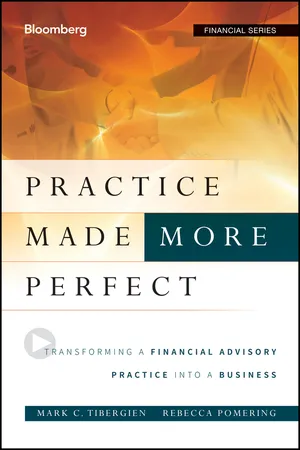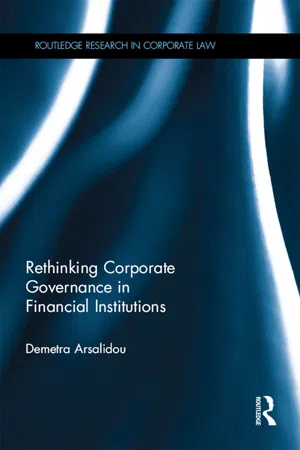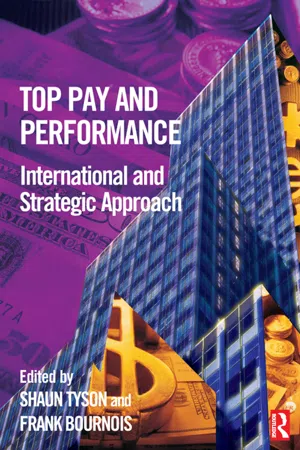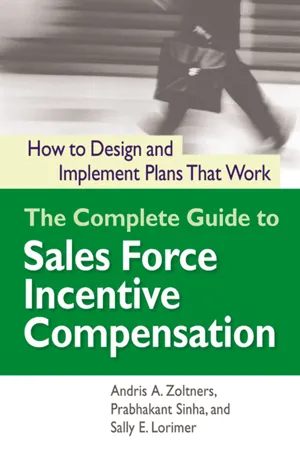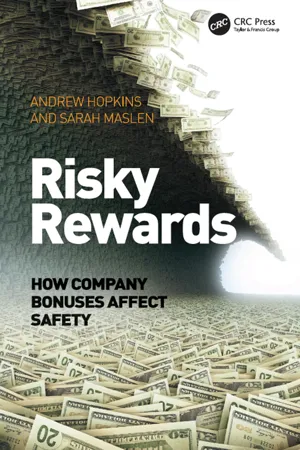Business
Incentive Compensation
Incentive compensation refers to a form of payment or reward that is tied to an individual's performance or the achievement of specific goals within a business. This type of compensation is designed to motivate employees to work towards the company's objectives and can take the form of bonuses, profit sharing, or stock options. Incentive compensation is often used to align the interests of employees with those of the organization.
Written by Perlego with AI-assistance
Related key terms
Related key terms
1 of 4
Related key terms
1 of 3
10 Key excerpts on "Incentive Compensation"
- eBook - ePub
Practice Made (More) Perfect
Transforming a Financial Advisory Practice Into a Business
- Mark C. Tibergien, Rebecca Pomering(Authors)
- 2011(Publication Date)
- Bloomberg Press(Publisher)
variable base pay. Like fixed base pay, commission-based pay is the amount an individual gets paid for doing the job. The more an individual's performance is tied to revenue generation, the more contingent on short-term variables that person's pay should be. The more an individual's role is related to processes or administration, the more fixed the compensation should be. But there are variations on these themes, depending on the type of culture and organization you're trying to create.Short-Term IncentiveA short-term incentive is an amount over and above base pay that should be awarded when the business or individual achieves certain milestones or exceeds expectations. Too many advisory firms pay a bonus rather than an incentive. A bonus is usually a surprise; it is not typically tied to any measurable expectation and tends to be discretionary. An incentive, on the other hand, links performance and behavior to the pay. It's important when setting up incentive programs to measure and reward the right types of performance and not merely achievement of the ordinary or expected.In compensating a professional advisor, it's typical to have some amount of compensation “at risk”—incentive pay based on the performance of the firm, the individual, or both. The theory is that incentive pay motivates a certain kind of behavior (determined by how you structure the incentive plan) and allows you to strike the desired balance of risk and reward between the professionals and the organization.Most firms that do not have incentive pay omit it either by neglect or because they do not know what to measure. In some cases, the reluctance seems to stem more from the desire not to judge or distinguish one individual's performance or contribution from another's at the risk of saying one is better than and the other is worse than. Some firms are reluctant to say that one person's skill set is more or less valued than another’s, that someone's performance is better or worse, or that someone's contribution is bigger or smaller. This kind of equanimity is not necessarily a bad idea; in fact, it's core to the culture at some firms. It does, however, affect the compensation program design significantly. - Demetra Arsalidou(Author)
- 2015(Publication Date)
- Routledge(Publisher)
261. In order to produce the ‘ideal employee behaviour’ a more successful method would be the offering of carrots instead of sticks and of incentives based on the specific job and the type of firm. 119 From the employers’ perspective, the elements adopted should aim to achieve the optimal incentives to breed the behaviour of the ‘ideal employee’. For employees, carrots take two forms: remuneration and promotion. At an abstract level, executive pay and bonuses help to attract the right people to the right job, people with skills, experience and a certain degree of talent perhaps. Companies need to offer competitive remuneration levels because they are expected to attract executives who can implement the right policies, using the company’s resources in the most advantageous way and generating the most value from those resources. 120 Properly structured bonuses paid for outstanding work and performance pay allocated on the basis of meeting future expectations, can help align shareholder and manager interests. Cleverly considered pay contracts that comprise of long-term incentive plans and share options have the potential to bring together the objectives of shareholders and directors whilst aiding shareholders to monitor directors’ actions. The role of pay is to incentivise and, once in the job, pay gives executives the motivation to try hard to ensure that the company (rather than them personally) benefits from their actions. Executives will not work really hard out of the goodness of their hearts; their remuneration can inspire them to do so. Hence, as Kershaw explains, companies should offer attractive packages to maximise the chances of enticing the right people to the job of directing – people with a high level of expertise and a good set of skills. This, in turn, will help to maximise the resources of the company- eBook - ePub
- Jay Galbraith, Diane Downey, Amy Kates(Authors)
- 2001(Publication Date)
- AMACOM(Publisher)
Organizations are relying more on team- and unit-based compensation than they have in the past. If your organization design assumes cooperation will be necessary because of the interdependence and complexity of the work, then the work should be motivated and rewarded through rewards that don't just focus on more than individual contributions. Team and unit incentives usually combine aspects of performance and skill-based pay.Performance Incentives. A performance goal is set for the team or business unit. It may be based on hard criteria, such as cost savings, output achieved, or deadlines met, or it may include some softer criteria, such as effective problem solving. When the goal is met, a bonus is given, either in the form of cash, stock, or noncash rewards. When it is linked to a gain-sharing or profit-sharing plan, the amount is tied to the overall financial performance of the unit.Skill-Based Pay. Teams can be rewarded for the collective skills they accumulate. The team is not rewarded until all team members reach a certain level, in order to encourage the more skilled employees to help others achieve competence. It is most commonly applied in team settings where the tasks of the team are specific and measurable and where there is a desire to make the team more flexible and autonomous by increasing the skills of all team members. As each team member learns and applies the skills that are needed by the team overall, that person's pay is increased. Team members cross-train in the work of others in order to lessen the impact of absenteeism on productivity. People are also rewarded for developing management skills. As these responsibilities are moved to the team, the organization can reduce the number of managers needed.Rewards based on collective effort and outcomes have some potential hazards.Distinguishing Which Organizational Level to Reward. - eBook - ePub
- Kay Maddox-Daines(Author)
- 2023(Publication Date)
- Routledge(Publisher)
2021a ) suggest that pay may be divided into two categories, base (or fixed pay) which is a guaranteed cash wage or salary paid to employees for their work for a contracted time period (this may include location allowances and other associated guaranteed payments) and, secondly, variable pay which is not guaranteed and may include bonus, incentives and overtime payments.Reward, which is sometimes described as compensation or remuneration, is possibly the most critical contract term in paid work (Anku et al., 2018 ). Compensation may be taken to mean just pay (both fixed and variable) whilst remuneration and reward might refer to the wider benefits package (CIPD, 2022 ). Reward is an area of specialist knowledge in the CIPD HR profession map and focuses on designing and implementing strategies that ensure workers are rewarded in line with the organisational context and culture, relative to the external market environment (CIPD, 2021b ).Total reward
The CIPD (2022 ) suggest that reward generally covers all financial provisions made to employees, including cash pay and the wider benefits package (such as pensions or private medical insurance). It can also include wider provisions for employees, with the term ‘total reward’ sometimes used to encompass compensation and benefits. The notion of total reward is used to cover all aspects of work that are valued by people across the employee lifecycle. Examples might include flexible benefits, access to professional and career development, meaningful work, freedom and autonomy, opportunity for personal growth, being treated fairly, recognition of achievements, transparency in reward processes and outcomes, being able to raise matters of concern, being involved in decisions that affect the way work is done, flexible working options and supportive line managers. Total rewards will differ across organisations but Armstrong and Taylor (2020) suggest that both intrinsic and extrinsic factors will be prevalent in a total rewards package. For example, intrinsic factors might include quality of work, work and life balance, alignment of personal and organisation values, an enabling environment and growth opportunities. Extrinsic factors are tangible and might include professional memberships, retail discounts, health and welfare, performance share options, team awards etc. Taylor (2010 - eBook - ePub
- Shaun Tyson, Frank Bournois(Authors)
- 2005(Publication Date)
- Routledge(Publisher)
Waters and Morrison, 2003 ). Microsoft employees shared $16.3 billion in option profits in 2000. Instead of share options, Microsoft said it would be granting restricted stock that would vest after five years. Steve Balmer, Microsoft’s CEO, said that ‘the shift away from share options reflected the unhappiness amongst the company’s employees as its [Microsoft’s] shares have languished over recent years’.As can be seen, the arguments for and against whether incentive plans are worth having are not simple, either from the employee or employer point of view. If the share price at the exercise date is less than, or even equal to, the option price, then the share option plan is likely to be seen as a disincentive – particularly if the employee was hoping to sell some shares to offset the cost of exercising the option.From the considerations above, it would appear that there is no guarantee that having an incentive will produce the behaviours and results the company requires. On the other hand, employees will look for incentive plans when they join a company because, if the company is successful, they will want recognition for their efforts and skill in creating that success. Furthermore, if the company wants to achieve its strategic goals, it will have to actively manage the performance of its people to achieve the goals. Incentive plans, clearly defined and properly controlled, can be very powerful management tools.The components of a pay policy
When discussing pay it is helpful to consider the component parts of the ‘package’ – called ‘total compensation’ in the USA or ‘total remuneration’ in the UK. It is generally accepted that there are four elements to the package, these being:- ■ base pay (guaranteed income or ‘come to work’ money)
- ■ short-term incentive pay (annual bonuses and the like)
- ■ benefits (medical, pension, life assurance etc.), and
- ■ longer-term incentives (share plans, LTIPs, etc.).
Straight away it can be seen that this simple breakdown is not as simple as it seems. For example, why provide benefits at all – surely employees could look after themselves or their families? Depending on whether they are single, married, have dependent children, both partners are in employment, etc. will lead one to question the sense and indeed the perceived value of a ‘standard’ set of benefits, regardless of the employees’ personal circumstances. This variation in benefit requirement has helped to create a whole industry devoted to the promotion of ‘flexible benefits’, a system whereby the benefits can be carried within a total budget, according to the needs of the recipient. - eBook - ePub
Hard Facts, Dangerous Half-Truths, and Total Nonsense
Profiting from Evidence-based Management
- Jeffrey Pfeffer, Robert I. Sutton(Authors)
- 2006(Publication Date)
- Harvard Business Review Press(Publisher)
a lot to people. So making mistakes in pay can cause people to withhold discretionary effort, ideas, and information—and can fuel unwanted turnover. Financial incentives have a potent impact on performance, but not necessarily in the positive ways that executives and their advisers anticipate.The Growth in Incentive Pay
There is no question that incentive pay is now ubiquitous and that the use of incentive-based pay systems has grown in recent decades, spreading from the United States to companies around the world. Even as early as the 1980s, surveys showed that over 80 percent of employees worked in organizations with merit pay plans, in which at least some employees received raises based on their rated performance.10 The prevalence of incentive or contingent pay has increased at all organizational levels during the last 15 years, with incentive schemes such as bonuses becoming particularly pervasive at more senior executive levels.11 Hewitt Associates, a compensation consulting firm, reported that in 1991, 51 percent of the companies participating in its salary survey offered at least one pay-for-performance plan. By 2003, that number had increased to 77 percent, after peaking at 81 percent in 2001. And 50 percent of the companies in 2003 had variable compensation plans that covered virtually every employee.12 Nor is this trend confined to the United States. A 2003 Hewitt survey of 115 Canadian organizations found that 81 percent offered pay-for-performance plans, up from 43 percent in 1994.13There is also growing interest in using merit pay in noncorporate settings such as schools and government, places that have traditionally not used contingent pay. In Albuquerque, New Mexico, garbage truck drivers were put on an incentive pay plan, and more than $4 million was paid out to the 180 unionized drivers over a six-year period.14 Denver schoolteachers are subject to a pay-for-performance system that rewards them for their students’ progress, while in Houston, every school employee receives a bonus based on students’ test scores. In Florida, school districts are now required to create salary systems that reward teachers for student performance.15 In the U.S. government in 2003, the administration proposed having the Office of Personnel Management administer a $500 million human capital performance fund to allow federal agencies to institute pay-for-performance practices. And the General Accounting Office issued a report praising governmental efforts to rely more heavily on financial incentives.16 In this spirit, the Office of Homeland Security unveiled a new incentive system that did away with traditional seniority-based pay in January 2005. Office of Personnel Management Director Kay Coles James boasted to reporters, “We really have created a system that rewards performance, not longevity . . . It can truly serve as a model for the rest of the federal government.”17 - Available until 29 Sep |Learn more
Human Resource Management
Strategic and International Perspectives
- Jonathan Crawshaw, Pawan Budhwar, Ann Davis, Jonathan Crawshaw, Pawan Budhwar, Ann Davis(Authors)
- 2020(Publication Date)
- SAGE Publications Ltd(Publisher)
employee value proposition (EVP). An effective reward strategy would result in both satisfied and engaged employees and an effective, high-performing organisation.Total reward All of the tools available to the employer that may be used to attract, motivate and retain employees. Total rewards include everything the employee perceives to be of value resulting from the employment relationship.Employee value proposition (EVP) ‘The collective array of programs that an organization offers in exchange for employment … encompassing every aspect of the employment experience – from the organization’s mission and values; to jobs, culture and colleagues; to the full portfolio of total rewards programs’ (Towers-Watson, 2012: 24).A typical total reward model will locate the reward package against the context of the firm’s business strategy, HR strategy and company culture. These shape which rewards are feasible, desirable and available to the organisation. These are influenced by broader institutional concerns and markets in which the company operates, along with labour market issues and cultural norms which may constrain or enhance its room for manoeuvre.The key levers available to the organisation in order to achieve these outcomes are the components of a total reward strategy (TRS). WorldatWork (2019) suggest six reward components which are described below.Compensation
Compensation refers to the monetary reward given to an employee for the service he or she provides. This typically includes a fixed base rate, the irreducible minimum that the organisation is contractually obliged to pay its employee for the time worked. There may be further variable components on top of this, some of which may be regular and predictable and others more discretionary or dependent on circumstance. This ‘plussage’ may be offered for possessing specific qualifications, or in recognition of working in dangerous conditions, spending time away from home, working shifts, unsociable hours or overtime. Employers may pay ‘time and a half’ or ‘double time’ for working beyond contracted hours or working on public holidays, or offer a fixed additional amount. - eBook - ePub
The Complete Guide to Sales Force Incentive Compensation
How to Design and Implement Plans That Work
- Andris Zoltners, Prabhakant Sinha, Sally Lorimer(Authors)
- 2006(Publication Date)
- AMACOM(Publisher)
Variable Pay Acknowledges a Salesperson's Success. Many sales jobs are devoid of the supportive social interaction that comes from working with supervisors and peers on a daily basis. A salesperson's primary social contacts are with her customers. The sales job also involves considerable rejection, and in some environments, customers perceive the salesperson as intrusive. An incentive payout provides both a reward for and a measure of a salesperson's success. Incentives provide the motivation to go forth and get the next sale. The sales job attracts people who are excited by the possibility of earning high returns through incentives. Many sales jobs in the United States would not attract people with the right skills, capabilities, and instincts if compensation consisted of salary alone.The Drivers of Sales Force Compensation Change
As markets and company strategies evolve, successful firms adapt their sales Incentive Compensation plans in order to ensure that sales force energy stays aligned appropriately. Most companies fine-tune their Incentive Compensation plans at least every year and make major changes to those plans at least every two to three years. The decision to change a sales Incentive Compensation plan is never taken lightly, as it can have a significant impact on customers, salespeople, and company performance.The Need to Adapt
Constant change is both an opportunity and a threat for a sales force. On the one hand, opportunities arise when new customers emerge, helpful technologies appear, competitors go out of business, or there is innovation in the company's products and sales processes. On the other hand, threats emerge when sales strategies become dated as customers change their buying approaches, the number of competitors increases and/or existing competitors become more aggressive, radical unanticipated technologies appear, and salespeople's skills and knowledge plateau. These changes can have a significant impact on the sales force. The scope of this impact often extends beyond the sales compensation plan and can include other aspects of sales management that define the sales job and influence the salesperson. - eBook - ePub
Risky Rewards
How Company Bonuses Affect Safety
- Andrew Hopkins, Sarah Maslen(Authors)
- 2019(Publication Date)
- CRC Press(Publisher)
Furthermore, in an attempt to reduce the level of subjectivity, supervisors are expected to provide a certain proportion of assessments in each category. A typical requirement would be that at least 70% of evaluations must lie in a central category (“average”, or “meets expectations” in the scale above), with perhaps only 5% rated as outstanding or exceptional. There is, finally, some pre-determined formula by which these rankings are converted into bonus payments.This system of performance evaluation can have powerful effects on people’s behaviour. One of the inquiries into the blowout in the Gulf of Mexico found that individual performance agreements often specified that employees should contribute to the cost reduction goals. The inquiry found further that of 13 employees whose evaluations it examined, 12 had documented ways in which they had saved the company large sums of money. One had put together a spread sheet showing how he had saved the company $490,000!12 Clearly the incentive arrangements were having the intended effect.But what motivations are these incentive schemes tapping? Presumably, in part, financial benefit is a direct motivator. But there is much more to it. The rating on the four- or five-point scale is a judgment by the supervisor of how well the individual is performing. The rating involves praise, or faint praise, or criticism by the supervisor. Powerful psychological incentives are therefore at work. People will seek to please their boss in order to achieve these psychological rewards, independently of any material rewards involved.Let us now relate this discussion of bonus arrangements for corporate employees to the theoretical considerations outlined earlier. That discussion was about the extent to which we are motivated by non-material considerations such as values and the opinions of others, as opposed to economic self-interest. It concluded that we are motivated by many things and that there are circumstances in which non-financial goals are the most important. However, this does not automatically undermine the strategy of paying financial incentives to corporate employees, because, curiously perhaps, these financial incentives do not rely for their effect on economic self-interest alone. Instead they tap a number of human motives, among them the need for approval, the need to belong and the need to be recognised as making a valuable contribution, all higher level motives in Maslow’s hierarchy of needs that transcend purely economic considerations. In short, the fact that human motivation is complex, and in particular more complex than neo-classical economic theory assumes, does not in itself undermine the potential of financial bonuses to influence behaviour in corporate settings. - eBook - ePub
- Herman Aguinis(Author)
- 2019(Publication Date)
- For Dummies(Publisher)
In this chapter, I cover the two main types of rewards: financial (also called “tangible”) and nonfinancial (also called “intangible”). These are the basic ingredients of a reward systems. Also, you learn about how to connect performance management to different types of rewards.Not All Rewards Are Created Equal
Until a few years ago, the terms “compensation” and “compensation and benefits” were used commonly. But more recently, these labels have been replaced with “rewards” and “total rewards.” A reward system is the set of processes for distributing both financial and nonfinancial rewards as part of an employment relationship.Financial rewards
An employee’s financial rewards include cash compensation (base pay, cost-of-living and merit pay, short-term incentives, and long-term incentives) and benefits (income protection, work–life focus, tuition reimbursement, and allowances).Nonfinancial rewards
Employees also receive nonfinancial rewards, which include recognition and status, employment security, challenging work, learning opportunities, and work-life focus, among others.Not all types of rewards are directly related to performance management because not all types of rewards are allocated based on performance. For example, some allocations are based exclusively on seniority.Different Types of Financial Rewards
There are six different types of financial rewards: base pay, cost-of-living adjustments and contingent pay, short-term incentives, long-term incentives, income protection, and allowances.Base pay
The base pay,
Index pages curate the most relevant extracts from our library of academic textbooks. They’ve been created using an in-house natural language model (NLM), each adding context and meaning to key research topics.
Explore more topic indexes
Explore more topic indexes
1 of 6
Explore more topic indexes
1 of 4
